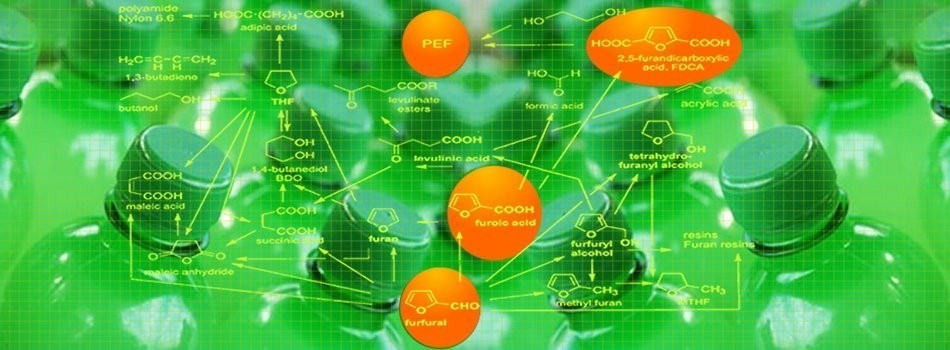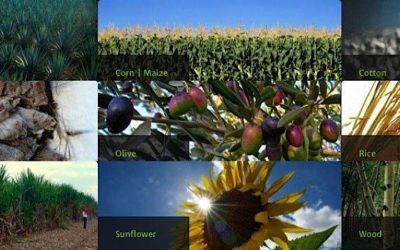Furfural as feedstock for PET alternatives.
Bio-renewable PEF (polyethylene furanoate) is an alternate and green plastic for soft drink bottles.
Pepsi was the first, but Coca Cola and Danone are also developing/introducing PEF bottles. PEF is made from ethylene glycol and FDCA (furan-2,5-dicarboxylic acid). As with most furfural derivatives, the chemistry is very old (and forgotten?): FDCA was first obtained in 1876 and is derived from furoic acid, which was first described in 1780. FDCA is one of 12 priority chemicals for establishing the “green” chemistry industry of the future, according to the US Department of Energy.
Although there are still technical hurdles to overcome, there are also chemical pathways being developed to commercially produce FDCA from HMF, which is derived from fructose (of saccharified cellulose). Viable options (case studies/models) are suggested in a recently published report [2], [3]. Other researchers of microbial metabolism of furanic compounds found that furfural and HMF degradation pathways converge at the level of 2-furoic acid [4].
Why Furfural?
Because it is already commercially made! Therefore, furfural should be the obvious choice as a platform chemical for alternatives to PET or other polymers. Furfural production no longer requires (costly) pilot plants, nor does it have to wait for the eventual construction of the next-generation biorefineries. Most importantly, furfural can be produced from a variety of biomass sources and its production can also be integrated into existing (e.g. sugar) and new agri-processing or bio-mass conversion (e.g. pulp) industries. Furfural production is also well suited to small scale biomass processors (micro-BioRefiners), i.e. in proximity of the biomass supply. Therefore, investments into furfural production can have a direct social-economic impact in creating new green rural jobs, now. It’s an investment into a US$5 billion business, a renaissance of a bio-renwable chemistry that goes beyond green “PET” soda bottles.
Low Cost IP Development
Since 1998, the DalinYebo team has successfully develop and commercialised IP in the furfural industry. Besides the perceived secretiveness of the business, …
… the biggest revelation for us was the fact that with relatively low development budgets, massive gains can be and are still to be made.
For many biorefiners, furfural is a problem or impurity that has to be removed. The hemicellulose is an integral part of the biomass and likewise our business model and approach to its conversion to furfural is integrated with the biomass processing:
We believe that many of the so-called “next generation bio-refining” processes can be adopted in a such a way that the removal of the furfural follows a “more or less” conventional process. Our Trade-Secrets are designed to enable collaborators to create new IP for own use or for licensing. The benefit is (a) a faster and lower-cost process development phase that integrates proven or known technology, which means that (b) investors can go and see “similar” plants that make use of selected unit-processes. Basically, furfural removal is a (paid for) pre-treatment stage of a bio-refinery and the resulting ligoncellulose can be use for the production of C6-molecule based chemicals/fuels or used as fuel for a CHP station. The reason we say “more or less” and “similar”: DalinYebo has overhauled and modernised the 1922 process in the way we integrate its mass and energy balance into other processes (e.g. bio-refinery, sugar or pulp mill), so it will look the same, but perform differently.
Should there be a proprietary process already that contains furfural in the process stream, DalinYebo certainly have the knowhow to assist in figuring out how to remove and commercialise the furfural. We are available to render our services on a consulting basis or find other commercial collaborations that will be of mutual benefit. The roots of our team’s knowhow are anchored in sugar milling, pulp & paper, ethanol and chemical production.
Related Articles:
References:
[1] B. Kamm, M. Kamm. M. Schmidt, T. Hirth and M. Schulze, Biorefineries – Industrial Processes and Products, ed. B. Kamm, P.R. Gruber and M. Kamm, Wiley-VCH Verlag GmbH & Co. KGaA, Weinheim, Germany, 2006, vol. 2, ch. 3, pp. 97-149.
[2] A. Eerhart, W. J.J. Huijgen, R. J.H. Grisel, J. C. van der Waal, E. de Jong, A. de Sousa Dias, A. Faaij and M. K. Patel, RSC Adv., 2013, DOI: 10.1039/C3RA43512A.
[3] CATalytic conversion of lignocellulose by an organosolv process into FURan derivatives (CATFUR) is part of the EOS Long Term Energy Research Strategy and is funded by a division of the Dutch Ministry of Economics Affairs.
[4] N. Wierckx, F. Koopman, H.J. Ruijssenaars and J.H. de Winde, Microbial degradation of furanic compounds: biochemistry, genetics, and impact, Appl Microbiol Biotechnol. 2011 December; 92(6): 1095–1105.





